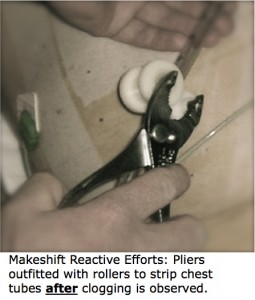Modernizing Your ICU Chest Tube Patency Protocol?
How Leading Hospitals are Developing Protocols to Proactively Maintain Chest Tube Patency after Heart Surgery:
Improving outcomes and reducing hospital costs is a continual effort in modern healthcare. For heart surgery patients, a good place to start is by focusing on something that is common to nearly all recovering patients.
All cardiac surgery patients have some degree of post-operative bleeding and chest tubes are required to evacuate this blood from the pleural and/or pericardial spaces in all patients.1,2Chest tube clogging, which has been found to occur in 36% of heart surgery patients, can cause blood to be retained around the heart and lungs, which can lead to Retained Blood Syndrome (RBS).3,4Chest tube clogging and RBS is also associated with increased postoperative complications such as POAF, AKI, post op infections, prolonged time on the ventilator, more hospital resources utilization and higher costs.3,4, 5, 6Keeping chest tubes free of obstructing clot can prevent these complications. Thus preventing chest tube clogging is an important clinical goal for all heart surgery programs
The link between obstructed chest tubes, RBS and poor outcomes has led many hospitals to look at their postoperative chest tube patency maintenance protocols as an area for potential continuous quality improvement. Very few programs have written chest tube patency protocols.2In the absence of defined tube management protocols to address chest tube clogging ICU nurses are left use makeshift methodslike milking, tapping, stripping, and open suction.7,8, 9These approaches are all reactive, and none have been shown to have clinical benefit. By the time clot is visualized in the chest tubes, the evacuation has often been impaired for some time, allowing to accumulate in the pleural and/or pericardial spaces. According to the most recent published best evidence review by ERAS Cardiac Surgery, chest tube stripping is ineffective and potentially harmful. They gave this a Class III A caution against, meaning it should be avoided based on high quality, published evidence.10 This has left many heart surgery programs uncertain about what protocols should exist to train ICU nurses to optimally maintain chest tube patency after cardiac surgery.
Now your program can be proactive in maintaining chest tube patency with PleuraFlow ACT, an FDA and CE approved device to prevent chest tube clogging and retained blood. PleuraFlow has been shown to be clinically efficient, to improve the evacuation of post-surgical blood, and to reduce the volume of blood retained in the surgical spaces. Numerous studies have shown using PleuraFlow act can reduce re-exploration for bleeding, effusions, POAF and other complications.11-18 For example, Sirch and colleagues demonstrated that utilizing PleuraFlow ACT in a defined preventive protocol has been shown to reduce RBS by 43% and POAF by 33%.17.
This included a significant reduction in the time on the ventilator postoperatively in the ICU. There have been several studies showing that active clearance of chest tubes reduces the need for take back for re exploration by up 55% to 100%.14, 15 This includes a randomized study from Montreal showing a 75% reduction and one Washington University showing a 100% reduction. Likewise Baribeau and colleagues recently showed not only fewer postoperative bloody pleural effusions, but also less AKI, fewer post op infections and a marked reduction in POAF. In this clinical trial they also noted a reduced time in the ICU and reduced hospital costs with active clearance of chest tubes using PleuraFlow.18 In the most recent ERAS publication active clearance of chest tubes was given a Level 1 recommendation based on published evidence that it can help reduce retained blood.10When teams combine this with the other elements of the ERAS bundle may do even more to help minimize complications and reduce the backlog of patients that can build up when there is a bottleneck in the ICU.
With PleuraFlow ACT, a growing number of hospitals are now formally implementing ERAS compliant chest tube clearance protocols to proactively maintain chest tube patency in the early hours after surgery in the ICU. By actively and systematically maintaining chest tube patency, top hospitals are working to improve the clinical efficiency of chest tube management process and decreasing the incidence of RBS and POAF and reducing the cost of care.
For more information about how developing chest tube patency protocols and PleuraFlow ACT can help your facility address this common and costly problem, contact us.
- Karimov JH, Gillinov AM, Schenck L, et al. Incidence of chest tube clogging after cardiac surgery: a single-center prospective observational study. Eur J Cardiothorac Surg. 2013;44(6):1029-1036. doi:10.1093/ejcts/ezt140
- Shalli S, Saeed D, Fukamachi K, et al. Chest tube selection in cardiac and thoracic surgery: a surgery of chest tube-related complications and their management. J Card Surg. 2009;24(5):503-509. doi:10.1111/j.1540-8191.2009.00905.x
- Balzer F, von Heymann C, Boyle EM, Wernecke KD, Grubitzsch H, Sander M. Impact of retained blood requiring reintervention on outcomes after cardiac surgery. J Thorac Cardiovasc Surg. 2016;152(2):595-601.e4. doi:10.1016/j.jtcvs.2016.03.086
- Tauriainen TKE, Morosin MA, Airaksinen J, Biancari F. Outcome after procedures for retained blood syndrome in coronary surgery. Eur J Cardiothorac Surg. 2017;51(6):1078-1085. doi:10.1093/ejcts/ezx015
- St-Onge S, Perrault LP, Demers P, et al. Pericardial blood as a trigger for postoperative atrial fibrillation after cardiac surgery. Ann Thorac Surg. 2018;105(1):321-328. doi:10.1016/j.athoracsur.2017.07.045
- Boyle EM, Gillinov AM, Cohn WE, Ley SJ, Fischlein T, Perrault LP. Retained Blood Syndrome After Cardiac Surgery: A new look at an old problem. Innovations in cardiovascular and thoracic surgery. 2015 Sept/Oct:10(5):296-303.
- Day TG, Perring RR, Gofton K. Is manipulation of mediastinal chest drains useful or harmful after cardiac surgery? Interact Cardiovasc Thorac Surg. 2008;7(5):888-890. doi:10.1510/icvts.2008.185413
- Halm MA. To strip or not to strip? Physiological effects of chest tube manipulation. Am J Crit Care. 2007;16(6):609-612.
- Boyacıoğlu K, Kalender M, Özkaynak B, Mert B, Kayalar N, Erentuğ V. A new use of Fogarty catheter: chest tube clearance. Heart Lung Circ. 2014;23(10):e229-e230. doi:10.1016/j.hlc.2014.04.255
- Engleman DT, Ben Ali W, Williams JB, et al. Guidelines for preoperative care in cardiac surgery: Enhanced recovery after surgery society recommendations. JAMA Surg. 2019; 154: 755-766. doi:10.1001/jamasurg.2019.1154
- Shiose, A.; Takaseya, T.; Fumoto, H; Arakawa, Y.; Horai, T.; Boyle, E. M.; Gillinov, A. M.; Fukamachi, K. Improved drainage with active chest tube clearance. Interactive Cardiovascular and Thoracic Surgery 10(5):685-688.
- Arakawa, Yoko; Shiose, Akira; Takaseya, Tohru; Fumoto, Hideyuki; Kim, Hyun-II; Boyle, Edward M.; Gillinov, A. Marc; Fukamachi, Kiyotaka. “Superior Chest Drainage With an Active Tube Clearance System: Evaluation of a Downsized Chest Tube.” The Annals of Thoracic Surgery 91(2):580-583.
- Perrault LP, Pellerin M, Carrier M, et al. The PleuraFlow Active chest tube clearance system: initial clinical experience in adult cardiac surgery. Innovations (Phila). 2012;7(5):354-358.
- Grieshaber P, Heim N, Herzberg M, Niemann B, Roth P, Boening A. Active chest tube clearance after cardiac surgery is associated with reduced reexploration rates. Ann Thorac Surg. 2018;105(6):1771-1777. doi:10.1016/j.athoracsur.2018.01.002
- Maltais S, Davis ME, Haglund NA, et al. Active clearance of chest tubes reduces re-exploration for bleeding after ventricular assist device implantation. ASAIO J. 2016;62(6):704-709. doi:10.1097/MAT.0000000000000437
- St-Onge S, Ben Ali W, Bouhout I, et al. Examining the impact of active clearance of chest drainage catheters on postoperative atrial fibrillation. J Thorac Cardiovasc Surg. 2017;154(2):501-508. doi:10.1016/j.jtcvs.2017.03.046
- Sirch J, Ledwon M, Püski T, Boyle EM, Pfeiffer S, Fischlein T. Active clearance of chest drainage catheters reduces retained blood. J Thorac Cardiovasc Surg. 2016;151(3):832-838.e2. doi:10.1016/j.jtcvs.2015.10.015
- Baribeau Y, Westbrook B, Baribeau Y, et al. Active clearance of chest tubes is associated with reduced postoperative complications and costs after cardiac surgery: a propensity matched analysis. J Cardiothorac Surg. 2019;14(1):192. doi.org/10.1186/s13019-019-0999-3

